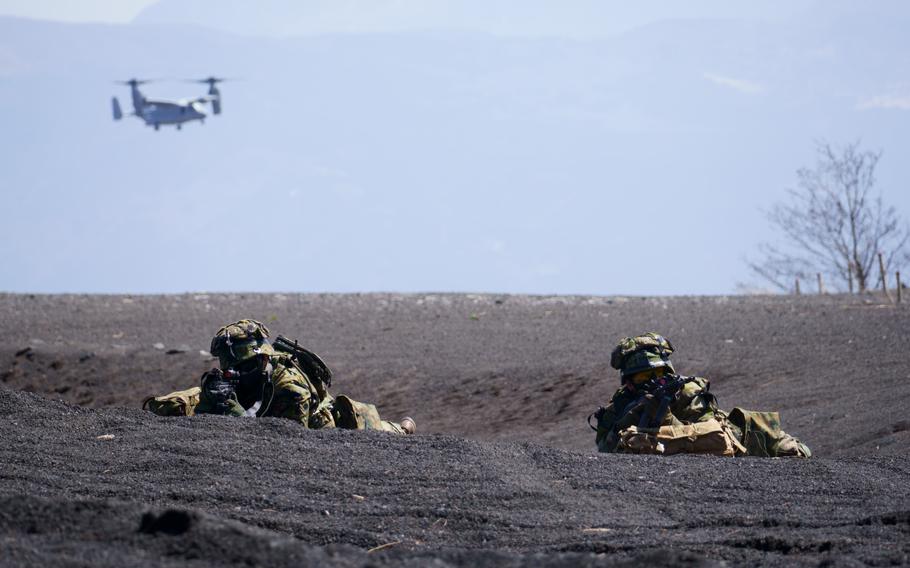
Japanese troops from 1st Amphibious Rapid Deployment Regiment secure a space for a U.S. Marine Corps MV-22 Osprey to land during a combined exercise in Japan on March 15, 2022. (Akifumi Ishikawa/Stars and Stripes)
YOKOTA AIR BASE, Japan – U.S. President Joe Biden and Japanese Prime Minister Fumio Kishida will reveal a plan to restructure the U.S. military command in Japan next month in light of concerns over China, The Financial Times reported Sunday.
The aim is to boost military planning and drills involving the allies, according to the newspaper, which did not reveal its sources. The two leaders will announce the plan during a meeting April 10 at the White House, the newspaper said.
U.S. Forces Japan, headquartered at Yokota Air Base in western Tokyo, referred queries Monday to the Office of the Secretary of Defense. A spokesman for the office, John Supple, by email to Stars and Stripes declined to comment on the newspaper’s report.
Chief Cabinet Secretary Yoshimasa Hayashi during a Monday news conference said he is aware of the reports but declined to comment.
Discussions are underway between Japan and the United States about strengthening cooperation on command and control to improve their militaries’ readiness, training methods and ability to use each other’s equipment, Hayashi said.
Japan is working to create its own unified command capable of central, operational control over the three Self-Defense Forces – air, maritime and ground - by March 2025.
“I understand that nothing has been decided at this point regarding the structure of the U.S. side, including strengthening the functions of the U.S. Forces Japan Headquarters,” Hayashi said.
Japan has ramped up its military spending in recent years in response to a Chinese military build-up and a pledge by Chinese President Xi Jinping to reunify the democratic, self-governing island of Taiwan with the mainland, by force if necessary.
Restructuring the U.S. military command in Japan could result in a combined U.S.-Japanese headquarters, according to security experts.
That would put U.S. and Japanese officers together coordinating training, drills, patrols and plans related to Japan’s defense, Grant Newsham, a retired Marine colonel and senior researcher with the Japan Forum for Strategic Studies in Tokyo, said by email Monday.
“One wonders if the two sides will come up with an interim - and more immediate response - say, combining naval forces to a greater degree,” he said.
Alternatively, the two sides could try to perfect the concept before moving, which could mean a delay of five to 10 years, he said.
“One doesn’t really get a sense of urgency on either side -- and especially from the Pentagon,” he said. “Meanwhile, the PRC (China) and PLA (Chinese military) aren’t standing still.”
There has been talk for years about improving the U.S.-Japan alliance, Brad Glosserman, deputy director and visiting professor at the Center for Rule-Making Strategies at Tama University in Tokyo, said by email Monday.
He said the Combined Forces Command, the command that unifies U.S. Forces Korea with the South Korean armed forces, is one model.
The Combined Forces Command is led by USFK commander Gen. Paul LaCamera, with a South Korean deputy commander, and would serve as the operational headquarters for all U.S. and South Korean forces in a conflict.
The push for a combined headquarters in Japan is shaped by concerns about the defense of Taiwan, added James Brown, an international affairs expert at Temple University’s Japan campus.
The two allies don’t need to amend their mutual defense treaty in order to restructure the U.S. command, he said by email the same day.
“An important change in that regard has already occurred with the reinterpretation of the (Japanese) constitution to permit collective self-defense,” he said. “Rather, this is about making organizational changes to enable the alliance to function more effectively in a crisis.”
Stars and Stripes reporter Hana Kusumoto contributed to this report.